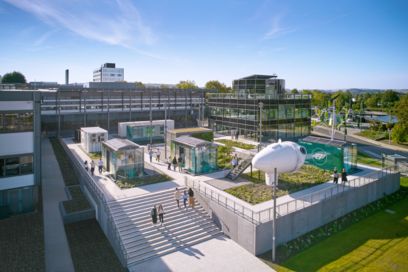The key technologies of the All Electric Society

Empowering the All Electric Society
Sustainable technologies are essential and are empowering the All Electric Society. And the good news is that they are already largely available. The task now is to use these technologies in a targeted manner for sector coupling. This is because they have what it takes to profitably connect industries that have previously existed in isolation from one another.
We have summarized those technologies that we at Phoenix Contact consider to be elementary in the following: Together with our expertise, we will turn these into technologies for a sustainable world together.

Manufacturing-X
In the context of industrial digitalization, also referred to as Manufacturing-X, the asset administration shell (AAS) can be described as the digital twin of a device within an assembly.
The central nature of the AAS is to provide a data space in a standardized way. This standardization creates the basis for cross-manufacturer data exchange with different components and systems. However, the AAS does not only contain interfaces, but can also be used for key carbon figures. By making all interfaces and properties available in a standardized way, the digital twin opens up new ways of linking, in particular when it comes to sector coupling, and especially in terms of consistent value chains and networked systems.

Industrial security
For a long time now, hackers have no longer been concentrating on the IT world alone. The operation technology – or OT for short – has also fallen into their crosshairs. And because networked and intelligent systems are necessary for the All Electric Society, this development is also becoming increasingly relevant.
The role of industrial security is comprehensively protecting these system solutions. Ideally, automation solutions are already protected against cyberattacks from the start. These solutions include, for example, devices from the PLCnext Control family, which are certified in accordance with TÜV security requirements. At the end of the day, everything that has already been tested makes it easier and faster to secure an overall system – this also includes close cooperation with customers at the application level.

Feed-in management
Feed-in management is a key technology for future-capable grids and the associated sector coupling, because it helps to compensate for volatile electricity consumption volumes. It enables the safe integration of distributed power generation systems such as PV systems, combined heat and power plants, and wind parks into the power grid.
Here, it is important to feed the generated electricity into the grid such that the grid does not become overloaded or destabilized. Grid operators provide clear specifications regarding the utilization of the mains frequency and voltage as well as active and reactive power. The feed-in controller from Phoenix Contact helps to overcome the challenges of regulated feed-in. With the precise control of the feed-in power, it not only enables the efficient integration of renewable energy sources, but also the successful coupling of the sectors.

Energy storage
Wind and solar power depend on the weather. Therefore, energy storage systems are required to ensure a continuous power supply that is independent of natural fluctuations. These optimize energy management by storing excess energy in times of low demand and releasing it during peak times. This reduces the need for conventional peak load power stations, which helps to stabilize the grid.
Energy storage systems facilitate the transition to a renewable energy system, promote the development of sustainable infrastructure, and contribute to reducing carbon emissions. There are numerous ways of physically and chemically storing energy that is currently available but that will only be needed later on. Whether battery storage systems, storage power stations, or capacitors – energy storage systems are crucial for a sustainable and electrified future.

Power transmission and distribution
The increase in decentral power generation through solar systems, wind farms, and other sources is challenging the infrastructure of the grids. Power grids must be extended and digitalized cost-effectively to ensure flexible and future-capable power distribution, because the precise control of energy flows avoids bottlenecks, thus becoming the key to the All Electric Society. The analysis of consumption and generation data ensures cost-effective infrastructure development and sustainable power distribution.

DC grids
Whether AC or DC – in general, any conversion of electricity from one form of energy to another is the same as a loss-loss business. This statement is gaining in importance, especially in the All Electric Society, in which the boundaries between producers and buyers are becoming increasingly blurred.
In order to limit conversion losses, we rely on DC grids for sector coupling. The advantages of this are clear efficiency improvements, increased yields, and simplified installation. For example, renewable energy sources can be integrated more easily, because rectifiers can be done away with in the main. Another advantage of DC grids is that braking energy can be recovered more easily if electric motors become a generator during the braking process.

Communication and transmission technologies
Data creates transparency. Data can be used to obtain information that shows the interactions within interlinked subprocesses. Exchanging data requires communication – and here, automation technology in particular is undergoing a structural change. Communication technologies from broad public applications are increasingly finding their way into production halls. An example of this is Time-Sensitive Networking (TSN), a second Single Pair Ethernet (SPE), which was originally developed to connect multimedia applications in vehicles.
In the All Electric Society, these technologies improve communication between coupled sectors; and do so without the need for specifically developed chips. In the future, the economies of scale gained from the widespread use will make tailor-made communication even easier and also more cost-effective.

Charging infrastructure
The electrification of transportation is a key aspect of the All Electric Society and this requires a full-coverage and intelligent charging infrastructure. This is characterized by intelligent load management systems, which are a prerequisite for the efficient use of charging parks.
These systems not only enable fast charging with High Power Charging (HPC), but also bidirectional charging in the sense of the vehicle-to-grid concept. This is because electric vehicles are not only capable of taking in and storing energy, they can also feed it back into the grid when necessary. The intelligent CHARX control charging controller from Phoenix Contact is a prime example of how energy can be fed in based on priority, thus contributing to the stabilization of the grid and the integration of renewable energies.

Load management
Peak shaving and load shifting are the central terms for effective load management. Both methods avoid expensive peak loads in the power grid. In the case of peak shaving, peak loads are reduced by the targeted use of energy storage systems and sustainable energy management. In the case of load shifting, on the other hand, the aim is to shift energy consumption peaks to times when the demand is otherwise low.
To do this, it is important to gain an idea of the expected required quantities at an early stage, for example, with the help of comprehensive energy monitoring. Load management promotes the efficiency of the power supply and contributes to the design of a modern energy infrastructure for the All Electric Society.

Power-to-X
A central challenge of the All Electric Society lies in making electricity generated from renewable sources transportable and durable – and therefore decoupled from time.
One method of doing this is the electrolysis of green hydrogen from excess wind and solar power. Hydrogen can not only be transported and stored, but is also the basis for the synthesis of fuels such as methanol and ammonia. Furthermore, hydrogen is an important element for the process industry. Hydrogen has what it takes to replace the coke extracted from hard coal for use in steelworks, thus effectively decarbonizing steel production. And when used as a “fuel” for fuel cells, the controlled oxidation of hydrogen generates a lot of electrical and thermal energy. Both of these forms of energy can be used – when the energy is required.
Connect with our experts




